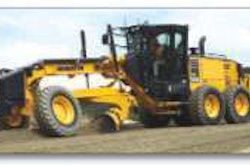How the rest of the country deals with equipment generated emissions
By Tom Jackson, Mike Anderson, Amy Materson and Marcia Gruver

While California awaits approval from the federal Environmental Protection Agency for its strict off-road emissions regulations, the rest of the states are moving much more cautiously. But if the California Air Resources Board gets EPA approval for its plan, the other 49 states will be free to adopt it as well.
For now, the rest of the country is looking at voluntary programs and demonstration projects and some emissions control built into bid documents in congested urban areas. Should the EPA get approval for new National Ambient Air Quality Standards (see the May issue of Equipment World or go to our California Crackdown Special Report on the website www.equipmentworld.com) and CARB get its approval, the other states could quickly pass into law regulations every bit as challenging as CARB’s.
Here’s a snapshot of what’s going on around the country currently:

New York, after adopting State Law 248, is seeing a bit of a backlash. State Law 248 requires contractors working on public contracts to retrofit their and Local Law 77 requires the use of best-available technology. Even though the law has exemptions that give off-road construction equipment an out, the law will seriously affect the construction materials side of the industry. Contractors were supposed to be given three years to gradually bring their vehicles into compliance but the Department of Environmental Conservation has just now begun to implement the rule, and cut the three years to 14 months.
The next step for New York will probably be that idling restrictions may go to off-road equipment. The best action is to avoid the state-by-state approach and look at it from a national standpoint, says Steve Stallmer, vice president of government and public affairs, AGC of New York. “There are so many different ways to do this. Our contractors are willing and able to comply, but you can’t expect them to handle the entire burden themselves.”
“Since some New Jersey contractors also work in New York, many have had to take the initiative and pay for repowers and retrofits in order to bid on jobs there.”
– Carol Fulton, associate executive director of the AGC of New Jersey
Pennsylvania has no statewide rule. Rather than focusing on heavy construction, the state has turned its attention to ports and power plants. Under the current particulate matter and ozone standards, Pittsburgh and Philadelphia are areas of concern; however, the upcoming federal standards may put the entire state in non-attainment, says Arleen Shulman, chief of the Division of Air Resources Management. Pennsylvania is also keeping a close eye on the Ozone Transport Commission, a multi-state organization created under the Clean Air Act, which is responsible for advising the EPA on ground level ozone in the Northeast and Mid-Atlantic and currently recommending aggressive NOx reductions.
Although New Jersey also has no mandatory requirement for non-road construction equipment, the industry there is carefully monitoring air quality initiatives throughout the Northeast. Since neighboring New York has implemented more stringent regulations and since some New Jersey contractors also work in New York, many have had to pay for repowers and retrofits in order to bid on jobs there, says Carol Fulton, associate executive director of the AGC of New Jersey.
New Jersey’s AGC has taken voluntary steps, such as creating an idling reduction policy, and conducting regular workshops and training. They also expedited ultra-low sulfur diesel usage ahead of schedule.

In the Southeastern states, air quality problems in certain cities are nearly as challenging as California’s. But the urban areas in violation of EPA air quality standards are spread out over a large geographic area.
To date none of these states are actively planning CARB-like restrictions for off-road diesel equipment. Several, however, are working with their state environmental agencies on voluntary programs to reduce equipment emissions. These initiatives are being undertaken more as demonstration projects rather than attempts to substantially cut overall emissions.
As with all the other Region 4 states, Georgia is not pursuing CARB-like regulations for the present, but the Georgia Air Quality Act does give the state the authority to adopt those measures in the future, says William Cook, engine and fuels unit manager for the Georgia Environmental Protection Division.
If the state deemed it was necessary to get certain cities into compliance with NAAQS, then the air protection branch of Georgia Environmental Protection Division would draft a rule and, after six to nine months of public comment, the rule would be submitted to the board of the Department of Natural Resources which would vote on the measure, Cook says. “If we were to adopt something that did require the used of emission control equipment, it would be specifically only for the non-attainment area,” Cook says. “But understand that that answer can vary widely depending on what we’re adopting.”

With the Federal EPA proposing tougher ambient air quality standards rules, any focus in the Midwest on tougher off-road equipment emissions may expand from select large urban centers to include smaller cities.
If the EPA’s new ozone levels are approved, cities such as Springfield, Missouri; Des Moines, Iowa; and Omaha, Nebraska, will be within range of being in non-attainment, says David Bryan, press officer for EPA Region 7. When an area reaches Clean Air Act non-attainment, the particular state has the primary responsibility to bring the area back into attainment status, says Bryan. In the case of the St. Louis area, which not only includes two states but two separate EPA regions, a multi-pollutant plan is in place as a test.
If the EPA’s new ozone levels are approved, cities such as Springfield, Missouri; Des Moines, Iowa; and Omaha, Nebraska, will be within range of being in non-attainment.
– David Bryan, press officer for EPA Region 7
Chicago is taking a three-pronged approach. Cook County passed a Clean Construction ordinance for projects within the county’s jurisdiction but the City of Chicago likewise passed an ordinance for its jurisdiction. Former governor Pat Quinn put together an executive order last year to have the Clean Construction requirement in the Chicago non-attainment area, which encompasses about an eight-county area including Cook County and City of Chicago.
That requirement is for any public construction project involving state funding and requires the construction company to put retrofit products on their equipment to bring them up to a Tier 2 equivalent standard. An example of such a project is the planned Illinois Tollway expansion.

At this point there isn’t any rulemaking that’s in the works for any kind of CARB adoption, says Morris Brown, technical specialist, air quality planning section, Texas Commission on Environmental Quality. “While some other states may jump on the CARB bandwagon, the issues are different here. I’m not saying we won’t entertain it in the future, I’m just saying at this point it’s not in our plans.”
Instead, the Brown points to the voluntary Texas Emissions Reduction Program, which has distributed about $780 million since 2001 to repower or replace more than 12,000 vehicles from a variety of industries, including construction. (More on TERP and other voluntary programs in the next installment of our series.) EW












